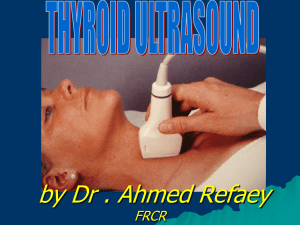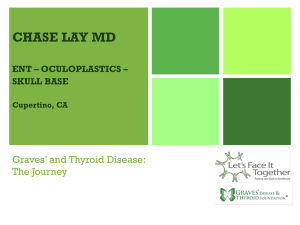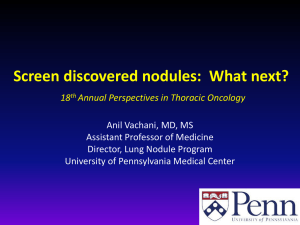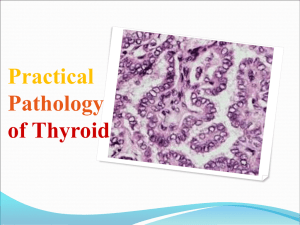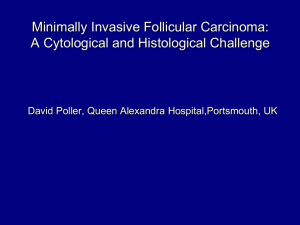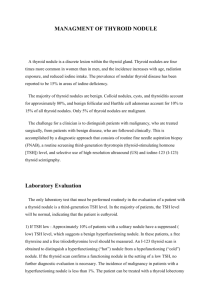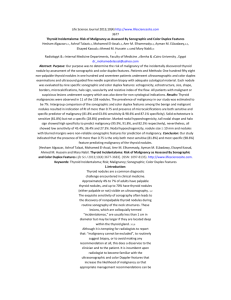Solitary thyroid nodules
advertisement
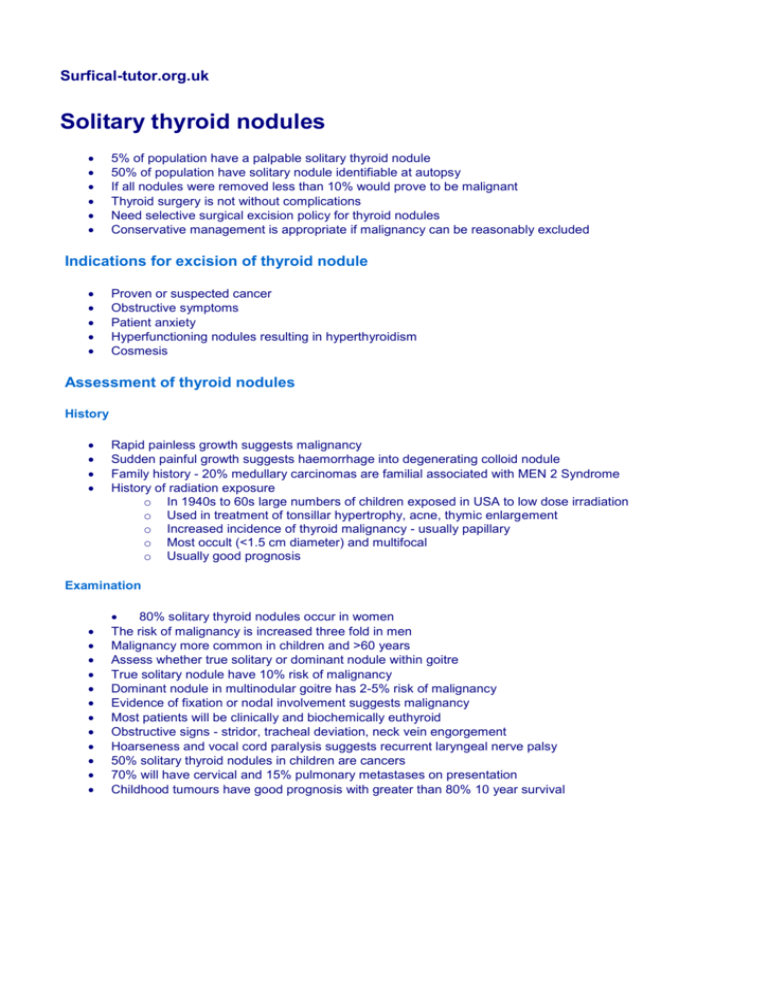
Surfical-tutor.org.uk Solitary thyroid nodules 5% of population have a palpable solitary thyroid nodule 50% of population have solitary nodule identifiable at autopsy If all nodules were removed less than 10% would prove to be malignant Thyroid surgery is not without complications Need selective surgical excision policy for thyroid nodules Conservative management is appropriate if malignancy can be reasonably excluded Indications for excision of thyroid nodule Proven or suspected cancer Obstructive symptoms Patient anxiety Hyperfunctioning nodules resulting in hyperthyroidism Cosmesis Assessment of thyroid nodules History Rapid painless growth suggests malignancy Sudden painful growth suggests haemorrhage into degenerating colloid nodule Family history - 20% medullary carcinomas are familial associated with MEN 2 Syndrome History of radiation exposure o In 1940s to 60s large numbers of children exposed in USA to low dose irradiation o Used in treatment of tonsillar hypertrophy, acne, thymic enlargement o Increased incidence of thyroid malignancy - usually papillary o Most occult (<1.5 cm diameter) and multifocal o Usually good prognosis Examination 80% solitary thyroid nodules occur in women The risk of malignancy is increased three fold in men Malignancy more common in children and >60 years Assess whether true solitary or dominant nodule within goitre True solitary nodule have 10% risk of malignancy Dominant nodule in multinodular goitre has 2-5% risk of malignancy Evidence of fixation or nodal involvement suggests malignancy Most patients will be clinically and biochemically euthyroid Obstructive signs - stridor, tracheal deviation, neck vein engorgement Hoarseness and vocal cord paralysis suggests recurrent laryngeal nerve palsy 50% solitary thyroid nodules in children are cancers 70% will have cervical and 15% pulmonary metastases on presentation Childhood tumours have good prognosis with greater than 80% 10 year survival Investigation Biochemical assessment Thyroid functional status - Free T4 and TSH Thyroid Antibodies - anti-thyroglobulin and anti-microsomal If positive family history an possibility of medullary carcinoma - calcitonin If suspicion of MEN2 (medullary carcinoma pheochromocytoma + (hyperPTH in IIa or mucosal neuromas in IIb) Syndrome will need 24 hr urinary catecholamine estimations to exclude phaeochromocytoma prior to surgery Standard radiography Chest radiography and thoracic inlet views if obstructive symptoms Isotope scanning 131I , 123I or 99Tch scanning provides functional assessment of thyroid Nodules classified as cold, warm or hot Unable to differentiate benign and malignant nodules Most solitary thyroid nodules are cold Most cancers arise in cold nodules Risk of cancer in a cold nodule is 10-15% Risk of tumour in a hot nodule is negligible Scintigraphy of minimal use in evaluation of solitary thyroid nodules Useful in recurrent thyroid swellings and retrosternal goitres Ultrasound Will define solitary and dominant nodules Will distinguish solid and cystic lesions Most sonographically solid lesions are benign Cancer can occur in the wall of a cystic lesion No reliable criteria to distinguish benign and malignant lesions Fine needle aspiration cytology Should be first line investigation of the solitary thyroid nodule With experienced cytologist diagnostic accuracy can be >95% Possible cytopathological diagnoses are: o Benign o Malignant o Indeterminate o Inadequate Can distinguish benign and malignant tumours except follicular neoplasms Diagnosis of follicular carcinoma depends on the visualisation capsular If follicular neoplasm on FNA lesion will require surgical excision False negative rate less than 5% in most institutions o Definitive FNA cytology allows: o Non-operative treatment with benign disease o Appropriate surgical treatment of thyroid cancers at initial operation o Surgery can be avoided in anaplastic tumours and lymphomas o Reduces total number of thyroid lobectomies o Increases yield of thyroid cancers Indications for surgery after FNA cytology All proven malignant nodules All cytologically diagnosed follicular neoplasms All lesions exhibiting an atypical but non-diagnostic cellular pattern on cytology Cystic nodules which recur after aspiration When on clinical grounds the index of suspicion of malignancy is high even if the cytology report suggests it is benign Complications of thyroidectomy Haemorrhage Wound Complications o Sepsis o Hypertrophic scarring Respiratory Obstruction o Laryngeal mucosal oedema o Clot deep to strap muscles o Bilateral incomplete recurrent laryngeal nerve palsies o Tracheomalacia Nerve Damage o Recurrent laryngeal nerve palsy o Incomplete - cord moves to midline o Complete - cord in cadaveric position o Preoperative cord inspection is essential o 3% population have asymptomatic recurrent laryngeal nerve palsy Hypocalcaemia Pneumothorax Air Embolism Thyroid Crisis o Fulminating hyperthyroidism o Hyperpyrexia o Arrhythmia o Cardiac Failure Recurrent hyperthyroidism Hypothyroidism Bibliography Bennedback F N, Perrild D I I, Iegerdus L. Diagnosis and treatment of the solitary thyroid nodule. Results of a European study. Clin Endocrinol 1999; 50: 357-363. Jones M K. Management of nodular thyroid disease. Br J Med 2001; 323: 293-294. Lawrence W, Kaplan B J. Diagnosis and management of patients with thyroid nodules. J Surg Oncol 2002; 80: 157-70 Russell C F J. The management of the solitary thyroid nodule. In: Taylor I Johnson C D (eds.) Recent Advances in Surgery 17. Churchill Livingston, London 1995 p1-16. Sheppard M C Franklyn J A. Management of the single thyroid nodule. Clin Endocrinol 1992; 37: 398 - 401. Watkinson J C. The evaluation of the solitary thyroid nodule. Clin Otolaryngol 1990; 15: 1 - 5. Wong C K M, Wheeler M H. Thyroid nodules: rational management. World J Surg 2000; 24: 934-941.
